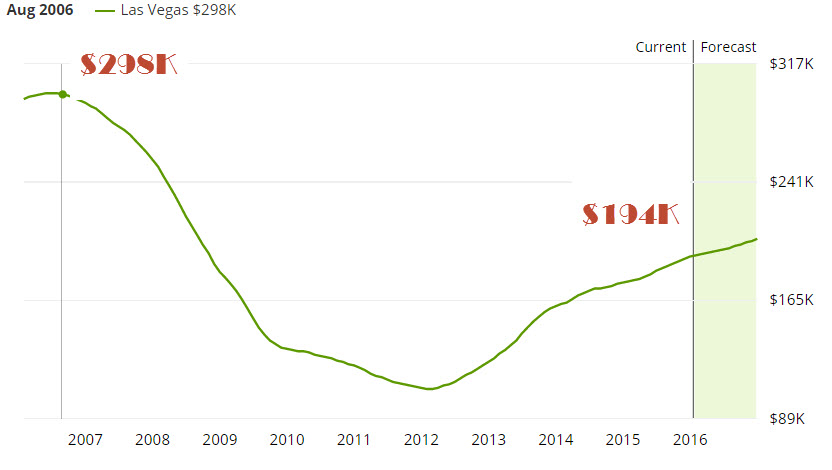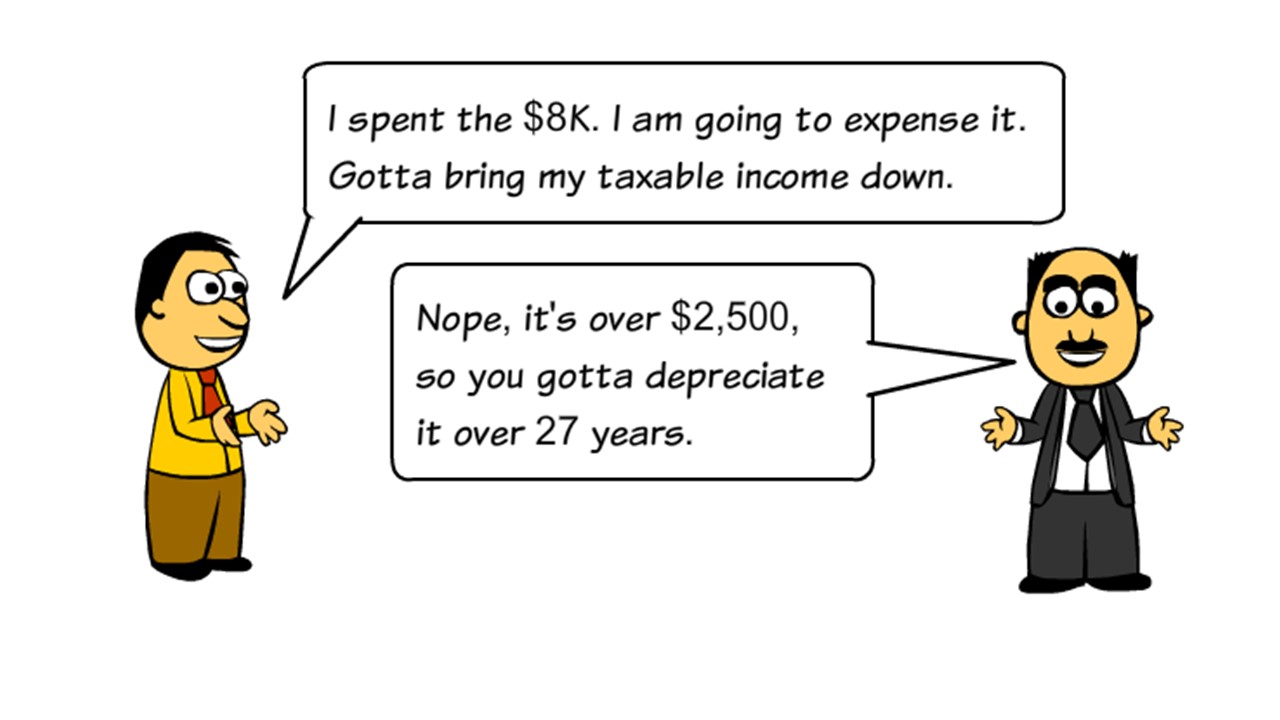From 2016, as a FYI, US tax laws keep changing. . .
In my mind, depreciation has two meanings – the common sense definition most people know intuitively, and the financial accounting definition which dictates how costs of fixed assets are spread out over many years. Note – if you are CPA, feel free to call me out on things I describe incorrectly. All feedback welcome.
#1. Economic Depreciation = things go down in value
No surprise – after all – it’s just the opposite of appreciation, right? Think about your car, computer, or roof. The older stuff gets, the more worn out it gets, and the less valuable it is.
Old stuff gets worn out and less useful; they say a new car depreciates in value about 20% the minute you drive it off the car dealer’s lot. Likewise, if you bought a home in Las Vegas in late 2006, you can see here that the average house fell from $298K to it’s current value of $194K in 2016. Update from 2022: the average price is $440K.
I wrote about rental properties here, explaining that it can provide good cash flow and a solid return on equity, but not to count on capital appreciation, because the graph below shows that values depreciate too. If prices do go up, good for you – just don’t bet your retirement on it.
 #2 Accounting Depreciation = allocating cost with time incurred
#2 Accounting Depreciation = allocating cost with time incurred
Here, it refers to the costs of a fixed asset (something that lasts many years) being allocated over several years. During MBA days we learn the “matching principle” which says to allocate revenues and costs to the the time period when they occur – that is why we have things like deferred liabilities, accrued expenses. Depreciation also tries to the cost allocation with revenues, but it is a non-cash expense (we already spent the money).
As an example of depreciation, if you buy a piece of equipment for $70K which will last for 10 years, you divide up the cost by 10. For your taxes, you can only deduct $7K of depreciation expense annually. Seems like a crappy deal, right?
In terms of cashflow, you spent $70K already (sad bank account), but your financial statements will only show a $7K depreciation expense in year one. The only upside is that you get $7K in expense in years #2, #3, #4 . . . #10, until it is fully depreciated.
Non-cash expense
Depreciation tends to understates profitability in the early years, and over-states it later on. On the balance sheet, this also gives a more accurate (albeit, still flawed) estimate of the salvage value. So after year four, you have taken $28K in depreciation expense, and the remaining (salvage) value is $42K.
Depreciate over how many years?
This is a good question. The US government has multiple schedules which tell you the “expected average life” of your asset for tax purposes. It’s approximate and actually imperfect, but at least it is consistent for taxes.
- For rental properties here, the duration of assets can vary from 5 years (carpets, appliances) to 27.5years (roofs, buildings).
- For agricultural assets here, the duration can vary from 3 years (hogs and tractors) to 15 years (drainage facilities) to 39 years (non-residential buildings)
Note, if you buy at $1,000 refrigerator, you will expense the cost of it over 5 years (appliance). So you cannot just take a $1,000 deduction of expense. Nope. You need to expense $200 annually for 5 years; you are taking the accounting depreciation of the refrigerator and chopping it into pieces that the IRS says you can expense annually.
Note, this has nothing to do with how long the refrigerator runs. That beautiful thing might run for 15 years.
Last year, I bought 2 air conditioning units for rental properties. They cost about $4K each and when I did my taxes, my CPA said the units had to be depreciated over 27.5 years. I was frustrated. Trust me, those things do not last that long. My CPA made it clear – that is what the US government has on their schedule – ergo – that is how much I can expense.
- I spent $8K (out of pocket)
- I can only expense $291 of it in year one. That sucks.
Depreciate or Expense?
As someone who has rental properties, I would rather expense costs than depreciate them – after all – I have already spent the money. Would I rather reduce my taxable income today or s. l. o. w. l. y. over time. Hell ya, deduct now.
$2,500 is the magic number
Looks like a few months ago, the IRS raised the maximum $ that you can deduct as an expense. . .from $500 up to $2,500. Nice, so if you are under that amount, deduct it immediately. If you are over $2,500, it is a depreciating asset and you only get to deduct 1/5 of the cost (5 year average life). Remember kids, $2,500 is the threshold now.
Apparently, larger companies with audited financials get to expense up to $5,000.

What happens if I replace it early?
My CPA explained that is the equipment goes bad before the 27.5 years, I can expense the remaining cost when I throw it away. Sheesh.
Accelerated depreciation
The government – in their increasing complexity – has different ways you can depreciate assets. There is straight-line depreciation that I mentioned earlier (simply dividing by the number of years). Then there is accelerated depreciation – where you can deduct more of the cost earlier. This is clearly more advantageous for the company, and some argue that this is the single biggest tax break for corporations here.
Watch out for EBITDA
This stands for earnings before interest, tax, depreciation and amortization. Forbes makes the case here that it is this is a poor way to evaluate businesses because depreciation is not a cash outlay. You are looking in the rear-view mirror because the company has already spent the money, and just benefiting from the lingering depreciation years later. Remember, depreciation is a non-cash expense. The money has already been spent. It does not reflect cashflow (expect that it lowers taxes slightly).
Others – including the incredibly successful private equity industry – would argue that EBITDA is a super useful metric because a) it focuses on the core business b) allows for comparison across different industries with varying level of capital expenditure and depreciation c) more accurate view of debt repayment ability (cash flow proxy).

Agreed EBIDTA is a poor metric, but industry relies on it to a large extent so business cannot ignore it.
What’s useful then? I’d say Shareholder Value Analysis which is essentially about business value as opposed to accounting results.
For me, you have to look at several measures – leading and lagging indicators. Shareholder value definitely.
Interestingly, I am less convinced there are really any good reasons to be publicly traded by more other than giving early round venture capitalists their money back. Giving the early guys an “exit” from their investment.
Thanks, this helped a lot!
Thanks for reading –
Nice and simple to I like it, Thx
Thanks for reading.
Hi, I read your article, and this information it’s very impressive and useful for me. Keep it up
Thank you so much.
Thanks for reading, like your blog too. . .keep sharing.
Hi John! Great article, as always. I am a big fan of your blog. The articles are fantastic and one can learn a lot. Is there any good accounting manual you could recommend?
Hello Manuel, that’s a great question. I learned through my MBA classes & reading lots of financial statements. For starters, Khan Academy, then from there, read through some financial statements of companies that have a simpler business model (e.g., manufacturing, retail) to understand 1) how they make money, 2) their capital structure 3) flow of funds. .. yes?
This article was very easy to understand and broken down very well in layman’s terms. I really enjoyed it. Thanks!